
Mendon is a town in Worcester County, Massachusetts, United States. The population was 6,228 at the 2020 census. Mendon is part of the Blackstone River Valley National Heritage Corridor, an early center of the industrial revolution in the United States. Mendon celebrated its 350th Anniversary on May 15, 2017.

Uxbridge is a town in Worcester County, Massachusetts first colonized in 1662 and incorporated in 1727. It was originally part of the town of Mendon, and named for the Earl of Uxbridge. The town is located 36 mi (58 km) southwest of Boston and 15 mi (24 km) south-southeast of Worcester, at the midpoint of the Blackstone Valley National Historic Park. The historical society notes that Uxbridge is the "Heart of The Blackstone Valley" and is also known as "the Cradle of the Industrial Revolution". Uxbridge was a prominent Textile center in the American Industrial Revolution. Two Quakers served as national leaders in the American anti-slavery movement. Uxbridge "weaves a tapestry of early America".

Mount Auburn Cemetery, located in Cambridge, Massachusetts, is the first rural or garden cemetery in the United States. It is the burial site of many prominent Boston Brahmins, and is a National Historic Landmark.
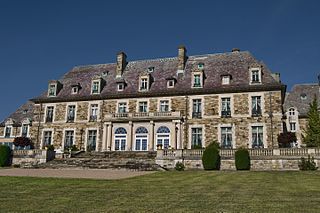
Aldrich Mansion is a late 19th-century property owned by the Roman Catholic Diocese of Providence since 1939. It is located by the scenic Narragansett Bay at 836 Warwick Neck Avenue in Warwick, Rhode Island, south of Providence, Rhode Island. Originally called Indian Oaks, and once the Senator Nelson W. Aldrich Estate. The extensive estate was developed in 1899 by Nelson W. Aldrich (1841–1915), a Republican Party politician who dominated state politics of the period. The main estate house is a sprawling stone French Renaissance structure with lavish interior decoration. The estate's surviving outbuildings include a boathouse and a caretaker's house, the latter located across Warwick Neck Avenue from the main estate. Aldrich's heirs sold the property to the Roman Catholic church in 1939, and it was adapted for use as a seminary. It now serves as the main campus of the Overbrook Academy, a Catholic girls' school. The property now known as "The Aldrich Mansion" still belongs to the Diocese of Providence, and is now available as a site for weddings, formal occasions, business conferences, etc. It is also occasionally used for film and television productions.

The Wheelockville District is an historic district located at Mendon and Henry streets in the village of Wheelockville in Uxbridge, Massachusetts. It encompasses a collection of modest Federal and Greek Revival period worker housing, built primarily to house families of workers at the nearby Waucantuck Mill Complex. The oldest houses in the area were built c. 1825–35, and include cottages built by the mill owners. A second phase of growth between about 1860 and 1885 resulted in the construction of a number of buildings with vernacular Victorian elements, as well as the somewhat more ornate Italianate Wheelock House at 173 Mendon Street, which was built for a manager at another Uxbridge mill. The district runs roughly along Mendon Street from Hecla Street to the junction of Mendon and Henry Streets, and then along those two streets for about six houses.
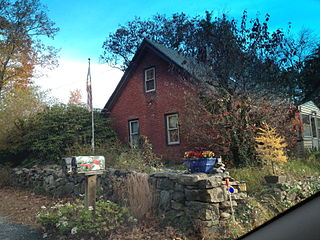
The Daniel Aldrich Cottage and Sawmill is a historic property at 364 Aldrich Street in Uxbridge, Massachusetts. It includes a c. 1830s late Federal style brick cottage, and at one time also included a rare surviving small-scale sawmill, built about 1835. They were built by Daniel Aldrich, member of a locally prominent family, were listed on the National Register of Historic Places in 1983.

St. Joseph Church is parish of the Roman Catholic Church in Cumberland, Rhode Island within the Diocese of Providence. It is known for its historic campus at 1303 Mendon Road, which includes a Gothic Revival style church along with two late 19th-century, clapboard-sheathed, wood-frame structures on the east side of Mendon Road. The church and its accompanying buildings were added to the National Register of Historic Places in 1982 as St. Joseph's Church Complex.

The Squantum Association is a private club in East Providence, Rhode Island on 947 Veterans Memorial Parkway. Its main Club House overlooks the Providence River on a rocky promontory. This Colonial Revival building was constructed in 1900 by Martin & Hall and added to the National Register of Historic Places in 1980. The brick bakehouse was built in 1899 and has weathered numerous hurricanes from its lofty perch right on the rocky coast. The "Cottage" is the oldest building on the property and was originally built as a billiard hall. Also surviving from the 19th century is the club office, formerly the manager's residence.

The Knight Estate is a historic estate in Warwick, Rhode Island, that is home to the Knight Campus of the Community College of Rhode Island. Developed as a country estate for a family of industrialists and later donated to the state, the main house and its outbuildings were listed on the United States National Register of Historic Places in 1984.
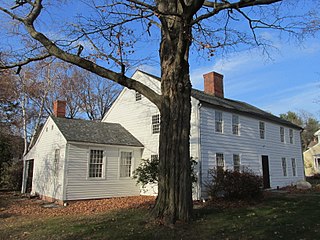
The Parsons, Shepherd, and Damon Houses Historic District is a historic district on the east side of downtown Northampton, Massachusetts encompassing a 2.5-acre (1.0 ha) property that was first laid out in 1654. Now owned by Historic Northampton, the property includes three houses built between 1730 and 1830. The district was added to the National Register of Historic Places in 2001.

The Benjamin Aldrich Homestead is a historic homestead east of the terminus of Aldrich Road, slightly east of Piper Hill in Colebrook, New Hampshire. Developed beginning in 1846, it is the oldest surviving farm property in the town. Its farmstead includes the original 1846 house and barns of the period. It was listed on the National Register of Historic Places in 2003, and the New Hampshire State Register of Historic Places in 2002.
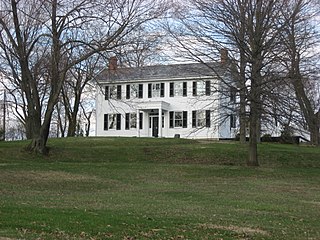
The James Beach Clow House is a historic house in northern Beaver County, Pennsylvania, United States. Located in North Sewickley Township near the community of Ellwood City, the house is a rare surviving example of 19th-century Greek Revival farmhouses in Beaver County.
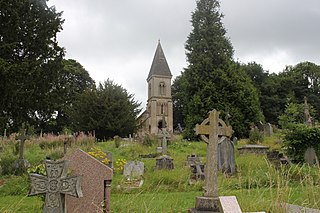
The Anglican Bath Abbey Cemetery, officially dedicated as the Cemetery of St Peter and St Paul, was laid out by noted cemetery designer and landscape architect John Claudius Loudon (1783–1843) between 1843 and 1844 on a picturesque hillside site overlooking Bath, Somerset, England.

The Frost Farm is a historic farmstead at 18 Fairwood Drive in Dublin, New Hampshire, United States. Built in 1855 and extensively restyled in 1910, it is a good example of a Georgian Revival summer house, with expansive views of nearby Mount Monadnock. The property was listed on the National Register of Historic Places in 1983. It is now home to the Fairwood Bible Institute.

The Marion Nichols Summer House is a historic house at 56 Love Lane in Hollis, New Hampshire, adjacent to the grounds of the Beaver Brook Association's conservation land. Built in 1935 for a wealthy widow, it is a locally rare example of a house built expressly as a summer residence. The house was listed on the National Register of Historic Places in 2003. It is now monitored for historical compliance by the Beaver Brook Association.

The Woodman Road Historic District of South Hampton, New Hampshire, is a small rural residential historic district consisting of two houses on either side of Woodman Road, a short way north of the state line between New Hampshire and Massachusetts. The Cornwell House, on the west side of the road, is a Greek Revival wood-frame house built c. 1850. Nearly opposite stands the c. 1830 Verge or Woodman House, which is known to have been used as a meeting place for a congregation of Free Will Baptists between 1830 and 1849.

The Waterford Historic District encompasses the well-preserved historic town center, also known as Waterford Flat, of the rural inland town of Waterford, Maine. Settled in 1775, the town grew around a site where Kedar Brook empties into Keoka Lake. The oldest surviving building, the Lake House, dates to 1797, while most of the houses were built before 1850. Prominent public buildings include a series designed by John Calvin Stevens, including the Knight Library, Wilkins Community Hall, and First Congregational Church. The district was listed on the National Register of Historic Places in 1980.

The Putney Village Historic District encompasses most of the main village and town center of Putney, Vermont. Settled in the 1760s, the village saw its major growth in the late 18th and early 19th century, and includes a cohesive collection with Federal and Greek Revival buildings, with a more modest number of important later additions, including the Italianate town hall. The district was listed on the National Register of Historic Places in 1986.

The Mill Village Historic District encompasses a small 19th-century industrial on Stowe Street in Waterbury, Vermont. The area is a compact and somewhat isolated example of a mill village of the mid-19th century; it is roughly bounded by Stowe Street, Graves Brook, and the northbound offramp of Exit 10 from Interstate 89. It was listed on the National Register of Historic Places in 1979.
Sutton Farm is a historic farm property at 4592 Dorset Road in Shelburne, Vermont. Established in 1788, the farm was operated continuously into the late 20th century by a single family, and includes a well-preserved Greek Revival farmhouse. It was listed on the National Register of Historic Places in 2004.






















